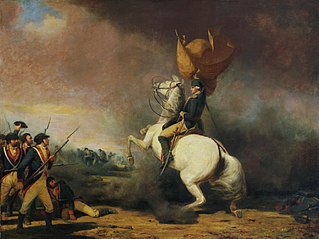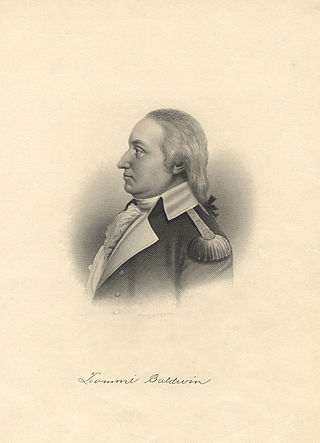Related Research Articles

The Battle of Long Island, also known as the Battle of Brooklyn and the Battle of Brooklyn Heights, was an action of the American Revolutionary War fought on August 27, 1776, at and near the western edge of Long Island in present-day Brooklyn. The British defeated the Continental Army and gained access to the strategically important Port of New York, which they held for the rest of the war. It was the first major battle to take place after the United States declared its independence on July 4, 1776, in Philadelphia. It was the largest battle of the Revolutionary War in terms of both troop deployment and combat.

The Battle of Princeton was a battle of the American Revolutionary War, fought near Princeton, New Jersey on January 3, 1777, and ending in a small victory for the Colonials. General Lord Cornwallis had left 1,400 British troops under the command of Lieutenant Colonel Charles Mawhood in Princeton. Following a surprise attack at Trenton early in the morning of December 26, 1776, General George Washington of the Continental Army decided to attack the British in New Jersey before entering the winter quarters. On December 30, he crossed the Delaware River back into New Jersey. His troops followed on January 3, 1777. Washington advanced to Princeton by a back road, where he pushed back a smaller British force but had to retreat before Cornwallis arrived with reinforcements. The battles of Trenton and Princeton were a boost to the morale of the patriot cause, leading many recruits to join the Continental Army in the spring.

The Battle of Trenton was a small but pivotal American Revolutionary War battle on the morning of December 26, 1776, in Trenton, New Jersey. After General George Washington's crossing of the Delaware River north of Trenton the previous night, Washington led the main body of the Continental Army against Hessian auxiliaries garrisoned at Trenton. After a brief battle, almost two-thirds of the Hessian force were captured, with negligible losses to the Americans. The battle significantly boosted the Continental Army's waning morale, and inspired re-enlistments.

The New York and New Jersey campaign in 1776 and the winter months of 1777 was a series of American Revolutionary War battles for control of the Port of New York and the state of New Jersey, fought between British forces under General Sir William Howe and the Continental Army under General George Washington. Howe was successful in driving Washington out of New York, but overextended his reach into New Jersey, and ended the New York and New Jersey campaign in January 1777 with only a few outposts near New York City under British control. The British held New York Harbor for the rest of the Revolutionary War, using it as a base for expeditions against other targets.

Joseph Plumb Martin was a soldier in the Connecticut Militia and Continental Army during the American Revolutionary War, and was mustered out as a 23-year-old Sergeant in a Sapper company. His published narrative of his experiences, re-discovered in the 1950s, has become a valuable resource for historians in understanding the conditions of a common soldier of that era, as well as the battles in which Martin participated.
Nathaniel Scudder was an American Founding Father, physician, and officer during the American Revolutionary War. He served as a delegate for New Jersey to the Continental Congress, where he was one of two delegates from New Jersey to sign the Articles of Confederation.
John Haslet was an American Presbyterian clergyman and soldier from Milford, in Kent County, Delaware. He was a veteran of the French and Indian War and an officer of the Continental Army in the American Revolution, serving as the first Colonel of the 1st Delaware Regiment. He was killed in action at the Battle of Princeton.

The Battle of Long Island was a significant British victory in the early stages of the American Revolutionary War over American forces under the command of General George Washington, and the opening battle in a successful British campaign to gain control of New York City in 1776. The Americans had lined New York's harbor with various levels of entrenchment and fortification, which were defended by an array of Continental Army forces and militia companies from New York and nearby states. After the British made an unopposed landing on Long Island in mid-August, Washington reinforced forward positions in the hills of central Brooklyn.
John Nixon was an American brigadier general in the Continental Army during the American Revolutionary War.
Robert Lawson was an officer from Virginia in the American Revolutionary War.

The Battle of Trenton was fought on December 26, 1776, during the American Revolutionary War campaign for New Jersey. In a surprise attack, the Continental Army led by George Washington attacked the winter quarters of a brigade composed primarily of German troops from Hesse-Kassel in Trenton, New Jersey. The Hessian brigade was under the command of Colonel Johann Rall; he died of wounds sustained in the battle, and about two thirds of his men were taken prisoner. It was the first major victory after a long string of defeats that had resulted in the loss of New York City, and was a significant boost to American morale. It was followed by two more American victories, first in a second battle at Trenton on January 2, 1777, and then on January 3 at Princeton.
James Johnston was an officer in the Tryon County Regiment and Lincoln County Regiments of the North Carolina militia in the American Revolution, a delegate to the North Carolina Provincial Congress in 1776, and a state senator in 1780–1782.
John Mott was a captain in the 1st Hunterdon Regiment of the New Jersey militia during the American Revolutionary War. He served as a guide to General George Washington and the Continental Army during their march down along the Delaware River prior to the Battle of Trenton.

The Red Lion Inn was a tavern in Colonial New York located on Long Island in what is today the New York City borough of Brooklyn.
Christopher Lippitt was a prominent Revolutionary War officer and founder one of the earliest textile mills in Rhode Island.
Daniel Hitchcock was born in Massachusetts and graduated from Yale University. He moved to Providence, Rhode Island, where he became an attorney and was suspected by the authorities of involvement in the Gaspee Affair. At the start of the American Revolutionary War he formed Hitchcock's Regiment of infantry in the Rhode Island Army of Observation. He was first appointed lieutenant colonel in command of the regiment when it marched to serve in the Siege of Boston in 1775. His regiment was renamed the 11th Continental Regiment during 1776. That year, he led his troops at Long Island, Harlem Heights, and White Plains.

The 26th Continental Regiment was an infantry unit of the Massachusetts Line during the American Revolutionary War. Gerrish's Regiment was raised in the early days of the war, and the regiment underwent name changes as the Continental Army was reorganized in 1776 and 1777. From 1777 onward, the unit was known as the 9th Massachusetts Regiment.

Oliver Spencer was a New Jersey officer during the American Revolutionary War and received a special commission to enlist and lead one of 16 Additional Continental Regiments. He was born in Connecticut and later moved to New Jersey, where he married Anna Ogden and became a tanner. He joined the revolutionary cause and engaged a British force in December 1776 as a major of New Jersey militia. On 15 January 1777 during the Forage War, his militiamen captured 70 German mercenaries. That month George Washington authorized him to recruit Spencer's Additional Continental Regiment. As colonel, he led this unit at Brandywine and Germantown in 1777 and Monmouth in 1778. His regiment participated in the Sullivan Expedition in 1779 and was disbanded at the beginning of 1781. The conflict having ruined his home and his tanning business, he moved to Ohio, where he served as a probate judge and militia commander. He was the nephew of General Joseph Spencer.
The 19th Connecticut Regiment was a military regiment in the American Revolutionary War. It was formed in 1774 by an act of the Connecticut General Assembly and was authorized 11 companies of volunteers from Enfield, East Windsor, Bolton, and the part of Hartford on the East side of the Connecticut river of Hartford County, Connecticut. The rolls of eight of those companies survive. While General George Washington was reorganizing the Continental Army from December 1775 through February 1776, during the Siege of Boston, Connecticut sent three regiments under Colonels James Wadsworth, Erastus Wolcott, and John Douglass. These regiments reached Boston in late January 1776 and remained for approximately six weeks.
References
- ↑ Lange, Gregg. Rally ’Round the Cannon: Lessons of Motivation and Desperation. Princeton Alumni Weekly December 1, 2016 https://paw.princeton.edu/article/rally-round-cannon-lessons-motivation-and-desperation Accessed April 29, 2017
- 1 2 13 Cong. Deb. 123–127 (1837) Remarks of Senator Garret D. Wall of New Jersey on the floor of the Senate
- ↑ Johnston, Henry Phelps; The Campaign of 1776 Around New York and Brooklyn, p112, 130
- 1 2 Johnston, Henry Phelps; The Campaign of 1776 Around New York and Brooklyn, p196
- ↑ Johnston, Henry Phelps; The Campaign of 1776 Around New York and Brooklyn, p176, 205